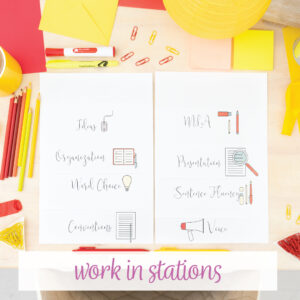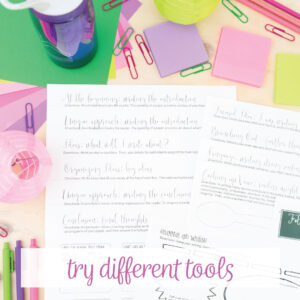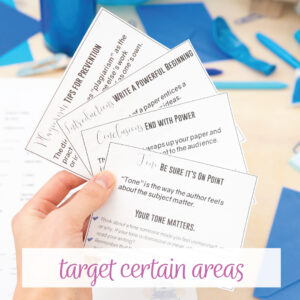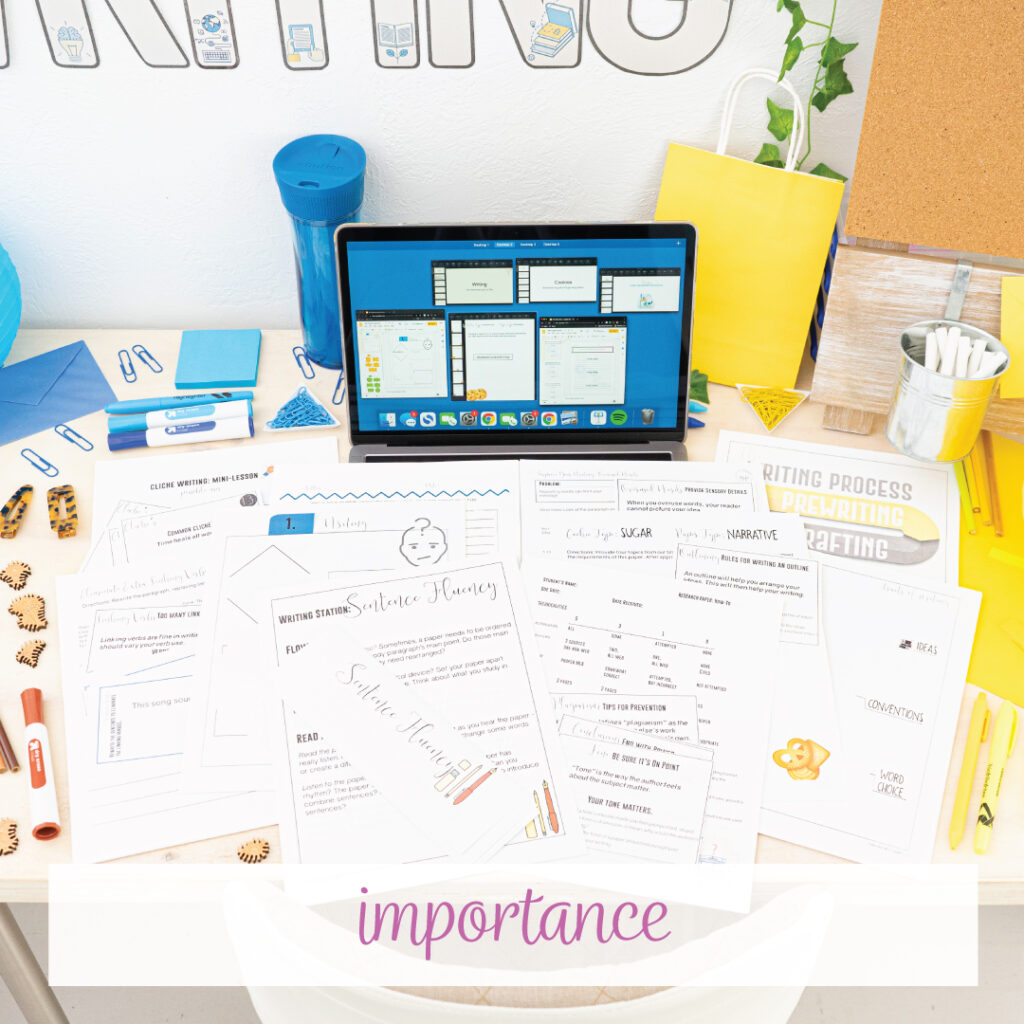Looking for tips for teaching reluctant writers? I can explain my process for you with some fun and simple writing activities.
Teaching writing cannot be done in one way. Some teachers swear by the writing workshop. Others only use outlines and note cards for student essays. I’ve implemented a variety of tools and methods in my writing lessons, some with better results. Overall, introducing a variety of methods and conferencing with students allow for students to take ownership of their writing process. When teachers express to students that together we will find the right process, then students become writers.
Writing is a personal exercise, and students bring various abilities and feelings to their writing assignments. This is good— but as teachers, how should teachers prepare for lessons? Some students may never enjoy writing or write in their spare time. What helps? Hopefully, with a variety of writing worksheets, writing activities, and flexibility they feel confident in their writing.
Adaptations take work and creativity. I never teach writing the same way twice, but I have developed some helpful ideas over the years. I wanted to organize these tips that help me reach more students. Writing activities for reluctant writers start with building community and continue throughout the entire process.
What are some strategies for engaging reluctant writers in the classroom?
To engage reluctant writers, try to provide choices for writing topics to increase autonomy, offer positive reinforcement and feedback, and encourage collaborative writing activities. And so… here are my four tips for teaching writing so that you can hopefully reach more students.
Build community.
You can build a classroom community in unlimited ways, but to engage reluctant writers, I have found that building a community around writing helps the most. Students who find engagement working through the writing process with me are more likely to engage in writing with me. After tons of experimentation, I have stumbled upon the perfect way to build community through writing: cookies.
Teaching the writing process should not be boring; rather, I use it as an opportunity to build a community of writers. To start the writing process, we brainstorm a complete list of everything we can think of considering cookies. Students of course mention different types of cookies—chocolate chip, oatmeal raisin, sugar, monster, and on. The more we brainstorm (which is a great opportunity to encourage!), the more students realize that these ideas can branch into other areas.
Suddenly, we are talking about toppings and icing for cookies, seasonal cookies, cookies with relatives, cookie recipe books, allergies, and on. I really encourage these brainstorming discussions because students realize they have great ideas. After a bit, I explain that all of these cookie ideas? They could fit in a book. We need to write a paper, so how can we narrow down the topic?
I let students narrow down the topic and model topic sentences for them. (In the picture above, you can see a sample informative chocolate chip introduction.) So if we decide to write about chocolate chip cookies, we could write about their creation, their popularity, and their toppings (chocolate drizzle, ice cream, sprinkles).
Sometimes, students understand the writing process through my modeling and their involvement. Other times, we continue and write out a body paragraph together. This activity always builds a community of writers because I can reference it throughout our entire paper assignment. Students gain confidence because they all have ideas about cookies.
Collaborate: stations, peer work, brainstorming.
Often, teaching reluctant writers involves interactive options. Writing activities can get students moving around the room, helping each other. Encourage group collaboration for generating ideas for individual students. For instance, students can outline their body paragraphs’ main ideas and get other opinions for support. (This will also help the writer spot repeated or unorganized information.) Sometimes fresh eyes can explain when two ideas should be combined and where a transition will clarify ideas.
When I ask student writers to work together, I provide basic guidelines. For instance, the reader might have an idea (great!) but if the writer feels the idea is not applicable, that is the writer’s right. Both sides of the peer work should be empowered.
Another interactive writing activity is a gallery walk. Ask students to leave their papers or prewriting on their desk. Give each student a pack of sticky notes. Students can walk around the room, adding one idea per sticky note. That way, each student’s paper isn’t covered in random markings.
Another writing activity includes the whole class. Ask students to volunteer one sentence at a time, like a sentence they aren’t thrilled with. Perhaps the sentence is boring or has little words that need tightened. Write the sentence and ask for class input. How can it be rearranged? Would making it a different type of sentence help? Should it be broken into two sentences? I use this collaborative activity especially when students need modeling for feedback.
At the very least, students should read another’s paper and provide feedback. Interactive peer editing can be a spin on the typical trading of papers. Put students in stations to help them focus on one aspect at a time.
Grow a community of collaboration in writing while teaching reluctant writers.
Try different tools.
Worksheets get a bad reputation. However, can they help some students? Hear me out.
Let’s define ‘worksheet.’ Teachers seldom use a writing worksheet with weak activities. (I’m referring to the activities that give worksheets a bad name: fill in the blank, copying from a textbook and then doing nothing.) Normally, writing worksheets contain brainstorming ideas and prompts. Other times they are graphic organizers, which help students sort through their ideas. The overall category of writing worksheets can include anything on a piece of paper.
Plus, writing worksheets can provide students with a concrete start. It helps some students to have ideas written when they begin typing. Peer edits (probably another form of a worksheet!) can be immensely helpful too. Plus, writing worksheets can provide structure and guidelines for using a thesaurus and citing sources. If a student feels overwhelmed by a portion of the writing process, clear steps in a worksheet might minimize anxiety.
Like so much, it depends on they way writing worksheets are utilized. Simple memorization without a connection to the writing assignment? No. Various outlining tools that each student chose to suit his/her own needs? Picture prompts? Yes.
Finally, work with students using the worksheets. Complete the activity with students. Use a digital version and add images, color, and notes to the worksheet. Show students that a worksheet can be a powerful tool.
Target certain areas.
With grammar and novel lesson plans, making their timelines is fairly predictable. You know that there will be a few days that require review and refocus but you can predict the length. With writing, I’ve found that I will rearrange lesson plans more than I don’t. When I work with reluctant writers, I am willing to let my lesson plans be a bit messy. I expect them to be thrown off.
For instance, a class may understand the funnel method for an introduction, but get hung up on subject-verb agreement. Another class may write beautiful conclusions, but not understand transitions. Because writing requires putting many components of ELA study together, I now make general writing lesson plans to allow for change as we continue.
I decide on a due date and adjust the lessons reaching up to that date. As classes move along, I know I may need to work on a certain area (support or vivid words) and wait a mini-lesson on transitions until the next writing assignment. With writing, it is an experiment every time I teach. Each class brings different strengths and weaknesses and lesson plans need reevaluated.
I am honest with students about this, and that honesty also helps with writing units. Writers are thankful that I show them the plan, that I am willing to accommodate. Finally, since I am building relationships with them as confident writers, we are comfortable discussing the end date for the writing assignment. Overall, one of the best ways to encourage reluctant writers is to talk to them.
Grading after teaching reluctant writers:
After all the work, it’s time to grade. (I did write about tricks to grading student writing.) Students personalize writing—and teachers want them to do that, to invest in their creations. An option is to grade alongside students, discussing their own writing alongside standards. Another option is for writers to evaluate themselves, and then you take over.
I implement writing skills in manageable chunks and when teaching writing which spreads to the grading.
We might not spread a love of writing to everyone, but hopefully, our classes can develop their own writing topics, apply ideas from mentor texts, and create a polished product. Teaching reluctant writers
Fun and simple writing activities benefit all students, especially while teaching reluctant writers. Activities can start small and then slowly build. Not only does that slow build encourage classes, but it also proves to them how capable they are.
I’m interested to read other teachers’ tips for teaching reluctant writers. What works for you with students who would rather not write?






